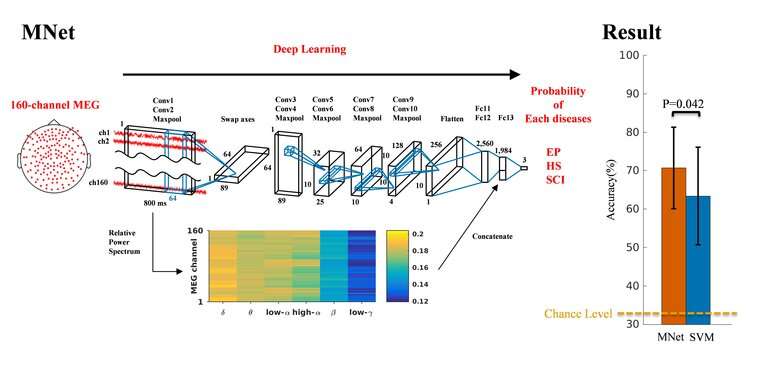Analyzing brain waveforms using neuroimaging big data to improve diagnosis

A team of researchers from Osaka University and The University of Tokyo developed MNet, an automatic diagnosis system for neurological diseases using magnetoencephalography (MEG), demonstrating the possibility of making automatic neurological disease diagnoses using MEG. Their research results were published in Scientific Reports.
MEG and electroencephalography (EEG) are essential for diagnosing neurological diseases such as epilepsy. MEG allows for the acquisition of detailed temporal-spatial patterns of human brain activity through the measurement of electro-magnetic field associated with neural activity, extracting detailed time-series signals from 160 sensors. Although information obtained from these tests is important for diagnosis, time and expertise are necessary for reading and analyzing, and abnormal waveform patterns may be missed.
Deep Neural Network (DNN), also known as deep learning, is a subset of machine learning in artificial intelligence (AI) and has drawn attention in recent years as a means for classifying data on various images, videos, and sounds at a high accuracy through a machine learning process using big data.
The AI-powered automatic classification system MNet, which utilizes DNN as a computational framework, is based on a neural network called EnvNet (end-to-end convolutional neural network for environmental sound classification) and can be trained to extract and learn features of neuroimaging signals unique to various neurological diseases from a massive amount of time-series neuroimaging data.
The team expected that the use of DNN would allow for the system to learn the characteristics of neurological diseases from many signals and classify patients with neurological diseases more accurately than conventional methods using waveforms.
With MNet, they tried to classify neuroimaging big data on 140 patients with epilepsy, 26 patients with spinal cord injuries, and 67 healthy subjects. The trained MNet succeeded in classifying healthy subjects and those with the two neurological diseases with an accuracy of over 70 percent and patients with epilepsy and healthy subjects with an accuracy of nearly 90 percent. The classification accuracy was significantly higher than that obtained by a support vector machine (SVM), a conventional general machine learning method based on waveforms (relative band powers of EEG signal). Moving forward, this technique will be used for diagnosis of various neurological diseases, evaluation of severity, prognosis, and efficacy of treatment.
"Machine learning is constantly advancing, with new techniques being developed all the time. However, no matter how much analytical methods advance, if the quality of underlying data is poor, a sharp distinction cannot be drawn. We carried out the process of machine learning by utilizing DNN, which processed big data mainly from the Osaka University Hospital Epilepsy Center. We'd like to increase the number and the types of diseases to be diagnosed without sacrificing quality of data so that our technique will be helpful in clinical practice," says researcher Jo Aoe of Osaka University.
More information: Jo Aoe et al. Automatic diagnosis of neurological diseases using MEG signals with a deep neural network, Scientific Reports (2019). DOI: 10.1038/s41598-019-41500-x
Journal information: Scientific Reports
Provided by Osaka University
















